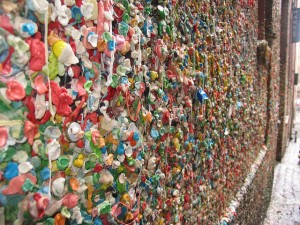If you live in London, chances are that you flit from one place to the other around the city, barely looking at your surroundings. Yet, once in while, something will stop you in your tracks. This is as likely to be a car burning a red light and almost taking one of your limbs in the process or a fantastic bit of street art. Personally, I prefer the latter.

Feeling a bit low the morning after the drastic cuts to the arts were announced by Arts Council England, my gaze was as low as the general morale when I noticed a man crouching on a street corner in Bloomsbury. Thinking he might be unwell and in need of help I cautiously approached only to find that he was engrossed in some kind of delicate activity involving numerous little pots of paint, a blow torch and… a wad of chewing gum flattened on the pavement. Was he trying to remove or hide it? Certainly not. He was painting the tiniest of frescoes on the discarded gluey substance, patiently softening it with his torch and adding varnish to it so it hardens before painting his chosen image with acrylic and fine brushes.
At that stage, I forgot he was sprawled on the ground and crouched down next to him to get a better look. There were two works on display at the corner of Mortimer and Wells that day: a finished one which depicted in great detail some aspect of the local history and a “work in progress” which represented the cafe in front of which he’d opted to set up his urban studio that day. The very idea of painting on discarded chewing gum is all wrong: I couldn’t possible think of less appealing canvas. What’s next? Sculptures made out cigarette butts? Yet the works were undeniably interesting in aesthetic and in critical terms. These overlooked signs of mindless consumerism are recycled into colourful, often meaningful, little vignettes of London life.

Indeed, Wilson takes commissions, requests from passers-by resulting in little memorials, declarations of love, political statements. One has to wonder if what he is doing is in itself a political statement as this mild mannered middle-aged man was arrested twice for his unusual artistic practice. Yet, street art is only walking the line of delinquent behaviour if it defaces private or public property. The beauty of working on “found rubbish” is that the crime was already committed by whoever discarded the thing in the first place. Artist Richard Dedomenici also uncovered that lovely loophole when he used posters that had been put up illegally to create new works by painting and drawing on them.
Another unique aspect of Wilson’s work is that, whereas a lot of street artists such as the infamous Banksy, Eine and E.vil work on large scales, claiming full walls as their playgrounds and becoming part of the larger landscape, Wilson’s works operate on a different scale. A bit like Slinkachu’s miniature urban installations, the tiny paintings come to your attention as a surprise, a secret only accessible to the people in the know. Indeed, once you’ve found your first one, you start noticing them everywhere because you actually keep an eye out. This in itself changes the way you look at your urban environment, favouring the detail to the big picture.

Now I intently look at the pavement so as not to miss one of Wilson’s many works that he has scattered throughout the city over the past 6 years. Perhaps I shouldn’t forget to look out for cars…














